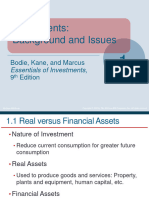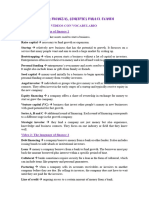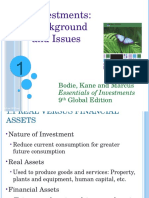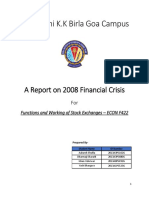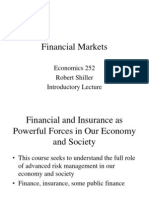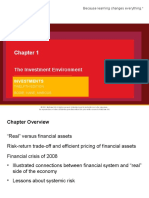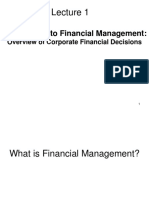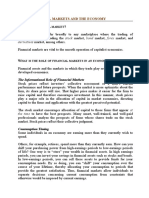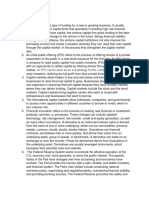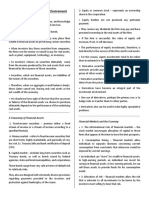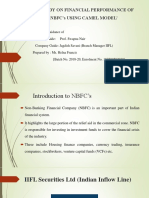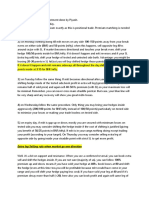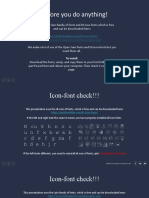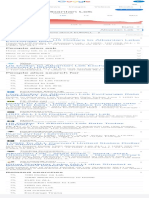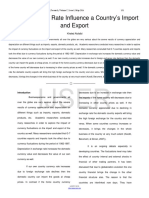This OpenStax ancillary resource is © Rice University under a CC BY 4.
0 International license; it may be reproduced or modified but
Chapter 16: Understanding Financial Management and Securities Markets
Watch the YouTube videos below, then answer the questions. Upload your completed
assignment to receive credit. Be more thorough than you think is necessary.
As the Corning situation described in Section 16.1 of your e-book demonstrates, financial
managers are required to assess an opportunity for profit compared to the potential for loss.
In finance, another way to call profit is return. Likewise, risk is another way think about the
potential for either a complete loss, or a return on investment that is less than an expected
level of return. Watch the following video and answer the questions below.
Finance Lesson 1: Risk/Return Tradeoff (4 Min)
https://youtu.be/ejpc9JS1GAw
1) After watching the video (which provided a real-life illustration from the 2008 financial
crisis) what would be some similar examples that could be made from the negative
economic consequences of the global COVID-19 pandemic? (type 5 to 6 sentences)
As stated in Section 16.2, the cost of inventory includes its purchase price, plus ordering,
handling, storage, interest, and insurance costs. Watch the video below for a brief summary of
the various components of the inventory management process. Hopefully you will note from
watching this first video all the areas where managers must decide how best to use
organizational funds to achieve successful movement and management of inventory, including
investments in systems, machinery and staff.
What Is Inventory Management? - Whiteboard Wednesday (4 Min)
https://youtu.be/sl5zEPRkp0U
Next, view the following video which showcases one of Amazon’s warehouses. Although this
video is a few years old, it does display a balance of both human and non-human touchpoints
along the way to getting a package out the door.
Amazon Inventory Management (2 Min)
https://youtu.be/zERrqLFotSY
2) Which processes do you think must be manual, or could this warehouse become 100%
automated at some point? (type 9 to 10 sentences)
�This OpenStax ancillary resource is © Rice University under a CC BY 4.0 International license; it may be reproduced or modified but
One fascinating aspect of the “SLAM” line described in the video is the ability of Amazon’s
computerized labeling and shipping apparatus to know the anticipated package weight, and
thus detect the likelihood of pulling the wrong item since the package apparently had an
incorrect weight.
3) Name and describe something else about Amazon’s inventory and shipping procedure
that seemed interesting or unusual to you? (type 5 to 6 sentences)
The video below discusses several financing options in detail. Watch the video and take notes
about the pros and cons of equity financing and of debt financing. Then, answer the questions
below.
Understanding Debt vs Equity Financing (Part 4) (5:30)
https://youtu.be/23Cg4X0caq8
4) List at least three pros of equity financing.
5) List at least three cons of equity financing.
6) List at least three pros of debt financing.
7) List at least three cons of debt financing.
Watch the Khan Academy video below after going back to Sections,16.4 and 16.5 to review that
content, and then re-read Section 16.6. Then, answer the questions below.
Bonds vs. Stocks (9 min)
https://youtu.be/rs1md3e4aYU
As described in Section 16.6, stocks, bonds, and other securities trade in securities markets.
8) What is a stock? (type 2 to 3 sentences)
9) What is a bond? (type 2 to 3 sentences)
10) What is the difference between a primary and a secondary market for stocks? (type 3 to
4 sentences)
�This OpenStax ancillary resource is © Rice University under a CC BY 4.0 International license; it may be reproduced or modified but
11) List at least three reasons someone would invest in stocks instead of investing in bonds.
(type three sentences)
12) List at least three reasons someone would invest in bonds instead of stocks. (type three
sentences)
13) List at least three different types of bonds. (type at least three sentences)
14) What type of bonds are considered to be the lowest risk? (type one word/phrase)
15) What type of bonds are considered to have the highest risk? (type one word/phrase)
In the following video, It starts with some insider information. Winthorpe and Valentine steal a
report that will cause the price of orange juice to fall, and replace it with a report that says OJ
prices will rise. They do this because they know their enemies, the Duke brothers, will trade on
the phony report.
Moving to the big scene, the Duke brothers, through their trader, starts buying OJ futures. Then
everyone buys. The value skyrockets.
Once the price gets to a high point, and the whole market thinks the price will only go up,
Winthorpe calls out a promise to sell OJ at that high price in the future. Essentially he is making
a bet that the price will fall. (He knows it will because he’s read the report.)
Basically, he buys a lot of orange juice for very cheap, and sell it for a lot of money. The Dukes
didn’t. Take a look at this classic movie scene that takes place on the floor of the stock
exchange:
Orange Juice Trade :D (6:30)
https://youtu.be/RLySXTIBS3c
16) What are the ethical considerations of using "inside information" for the Duke brothers
and Winthorpe and Valentine? (type 9 to 10 sentences)
�This OpenStax ancillary resource is © Rice University under a CC BY 4.0 International license; it may be reproduced or modified but
17) Should individual investors consider investing in speculative commodity futures?
Explain. (type 9 to 10 sentences)
In the clip from Margin Call below, the movie examines the thoughts and motivations of
individuals, instead of lumping everyone responsible for the disaster into some monolithic,
single-minded group. Even when the CEO of the film’s fictional bank makes the decision to sell
all the company’s toxic assets, an act that sets in motion the complete collapse of the entire
American financial system, it's an understandable and difficult, choice. What else can the CEO
do? If he doesn’t sell first and start the catastrophe, someone else will. The outcome is
inevitable.
That is the conundrum of what economists call a collective action problem. If no individual
person or firm’s actions can make a difference, the only reasonable thing to do is assume
everyone else will follow their most selfish (and possibly destructive) instincts. Everyone has an
incentive to follow the worst path they suspect others of also doing so. This explains not only
why bubbles burst, but also why they build up in the first place. Watch the following video.
Then, answer the questions below.
Margin Call (8/9) Movie CLIP - A Fire Sale (2011) HD (4 Min)
https://youtu.be/v4P4cS5jKmQ
18) Why did the investment banks start packaging and selling huge amounts of the
mortgage-backed securities that eventually triggered the crisis? (type 3 to 4 sentences)
19) What ethical actions could one of the traders taken? What would the consequences
have been? (type 4 to 5 sentences)



